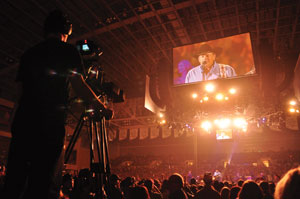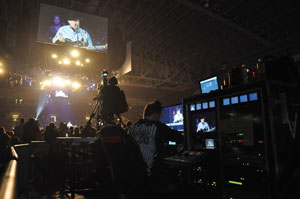George Strait's farewell tour wows fans - FULL ARTICLE
Each night during his recent multi-city North American tour, fans of country music legend George Strait were treated to a litany of familiar hits and a captivating video display that rivalled any of today’s younger artists. Strait might not have jumped around and danced on stage like his younger counterparts, but this “living legend” wowed them just the same.

Three Sony SD D50 cameras and four remotely controlled Sony box-style HD BRC-700 cameras capture the sights and sounds for the audience of George Strait’s latest tour. Photos by: ©Paolo Cascio Photography 2013 (www.paolocascio.com)
Veteran AV staging engineer Brian O’Neal — who has worked locally for the NBA’s Dallas Mavericks, NHL’s Dallas Stars, FOX SportstNet and numerous live music events — led a four-person team dedicated to projecting Strait’s live performance each night on a massive HD video “cube” (24ft screens on each side) as well as a four-sided LUXMAX LED wall. (This was O’Neal’s fourth year working with the Strait tour.)
“I walked around at a recent concert, and nearly everybody in the stands was looking at the video screens while George was performing,” O’Neal said. “We were the show, even though George was performing on stage. The producers were looking to us to represent the concert in its best light. It’s pretty challenging, and rewarding.”
Setup challenges
Each venue was different, and with roughly 20,000 to 30,000 people in attendance, the logistics often changed at the last minute. Nonetheless, the video team had to be up and ready to go in less than 90 minutes. The projectors might be located more than 800ft from the video control area, as they were during a recent concert in North Dakota, and the Gepco video camera cables and five-wire SMPTE 295-compliant AV cables had to be laid down and connected. It can be a challenge running SDI video that far, so the team often had to use distribution amplifiers or loop through the projectors (which O’Neal said he prefers not to do) to send the signals where they needed to go. Dog houses were also used at the projectors to support each position.

Country artist George Strait wows audiences with an impressive video display — complete with 24ft HD screens and a LUXMAX LED wall — on his tour. Photos by: ©Paolo Cascio Photography 2013 (www.paolocascio.com)
The team used a 1080i HD Barco FSN-150 video switcher to mix the images from three Sony SD D50 cameras (one handheld and two on tripods with long Canon zoom lenses), four remotely controlled Sony box-style HD BRC-700 cameras mounted on top of large poles, and two Iconix HD point-of-view cameras mounted on the sides of the keyboard and the steel guitar on stage. Four Barco FLM R22+ projectors fed the large video cube. O’Neal said the projectors — with picture-in-picture capability — displayed widescreen, high-contrast images, even in venues with lots of ambient light.
The professional video industry's #1 source for news, trends and product and tech information. Sign up below.
“We’ve got a 24ft mistake on screen if we mess up,” O’Neal said, “so we work hard to keep those mistakes to a minimum.”

Venues (and logistics) changed nightly, but the video team had to be up and ready to go in less than 90 minutes. Photos by: ©Paolo Cascio Photography 2013 (www.paolocascio.com)
O’Neal said that some venues featured a video ribbon around the stadium that the video team took advantage of by sending uncompressed .AVI files to the main house control room. This allowed the team to creatively display pre-produced images, live inserts and text messages that mirrored what the lighting department was doing from a color standpoint. O’Neal and his team work for Dallas-based AV production company Onstage Systems, which produced the tour from a technical standpoint. O’Neal worked with video equipment rental house VER in Dallas to design a rack of AV production gear that was rolled into each venue. He rewired the entire rack to meet the tour’s specific requirements.
The equipment rack — O’Neal called it his “Video Village” — featured an AJA Video Ki Pro digital disk recorder that recorded each performance at ProRes 4:2:2 to a 500GB hard drive. It also incorporated several AJA Video FS2 HD signal-processing components and BARCO ImagePRO-II HD video scalers for converting audio and video signals when necessary. (The downstream keyer of the switcher is used to add a watermark over the video using a Macintosh computer).

O’Neal can get his custom “Video Village” up and running within 90 minutes of receiving venue power. Photos by: ©Paolo Cascio Photography 2013 (www.paolocascio.com)
In addition, this year the tour provided local TV stations with a press feed, which included an embedded audio system. O’Neal took the separate audio feed from the concert and fed it through the tapeless memory of the Ki Pro system, which the journalists easily tapped into for their reports. The shows were then archived to DVD for the band to view on the tour bus between stops.
O’Neal said once the audio feeder and main stage were put in place, he could get his Video Village up and running within 90 minutes of receiving power from the venue and laying all of the SMPTE hybrid camera cables. The large projection screens themselves were hung within 30 minutes. O’Neal then shaded all of the cameras to keep them looking consistent and served as the video engineer in case an issue cropped up. (He said it rarely did.) The show was then directed by Dave Hare, who ran the BARCO switcher live. Hare also served as the lighting designer for the tour.
“No-frills” video
At the end of the day, O’Neal said there was nothing really “frilly” about the video setup, but that it was built to be reliable and entertain the audience; and it performed flawlessly on both accounts. His video team worked hard and with a sense of urgency, as Strait has said next year (2014) will be his last tour, ever.

The video team entertains the audience with a reliable, “no-frills” video setup, on what might be Strait’s last tour, ever. Photos by: ©Paolo Cascio Photography 2013 (www.paolocascio.com)
This year’s tour ended in April with a huge show that O’Neal said was much more complex than usual. Then, after a break, the video team will be back at it in 2014.
“I’ve engineered a lot of sports and all types of live events, but this tour has been the most challenging, and exhilarating, project of my entire career,” O’Neal said. “Every venue is different, so the logistics change on a nightly basis, but I’m working with the King of Country. [Strait has more number-one country hits than any other artist.] It never gets old.”
Project team:
- Onstage Systems/George Strait Tour video staff: Chase Anderson, projectionist; Matt Guthrie, handheld camera operator; Dave Hare, lighting and video director; Valentino Hernandez, robotic cameras; Brian O’Neal, tour video engineer
Technology at work:
- AJA Video: Ki Pro tapeless recorder, FS2 AV processors
- Barco: FSN-150 video switcher, FLM R22+ projectors, ImagePRO-II HD video scalers
- Canon: long zoom lenses
- Gepco: video camera cables
- Iconix: HD point-of-view cameras
- Sony: D50 handheld cameras, BRC-700 HD cameras
- LUXMAX: LED wall
—Michael Grotticelli regularly reports on the professional video and broadcast technology industries.
